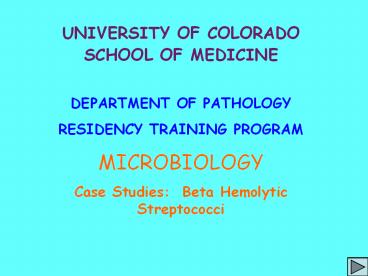UNIVERSITY OF COLORADO - PowerPoint PPT Presentation
1 / 11
Title:
UNIVERSITY OF COLORADO
Description:
UNIVERSITY OF COLORADO SCHOOL OF MEDICINE DEPARTMENT OF PATHOLOGY RESIDENCY TRAINING PROGRAM MICROBIOLOGY Case Studies: Beta Hemolytic Streptococci – PowerPoint PPT presentation
Number of Views:78
Avg rating:3.0/5.0
Title: UNIVERSITY OF COLORADO
1
UNIVERSITY OF COLORADO SCHOOL OF
MEDICINE DEPARTMENT OF PATHOLOGY RESIDENCY
TRAINING PROGRAM MICROBIOLOGY Case Studies Beta
Hemolytic Streptococci
2
Endometritis
In the left frame are illustrated the observation
of a Gram stain prepared from A 25 year old
woman is in her 37th week of gestation. A
vaginal-rectal culture was sent it to the
laboratory for culture. The right frame is a
photograph of the colonies growing on the surface
of a sheep blood agar plate. What is the most
probable diagnosis? What follow-up tests should
be performed?
ANSWER
3
Endometritis
Illustrated in the photographs are the rapid
4-hour and the overnight 18 24 hour CAMP
reactions. Describe the principle and the
procedure for each of these two tests.
What is the most likely species
identification? What other bacterial species also
produce a positive CAMP reaction? How are they
ruled out in this case? Why is it important to
incubate the plates at ambient temperature?
ANSWER
4
Endometritis
ADDITIONAL QUESTIONS 1. What is the importance
of detecting vaginal colonization of Group B
streptococci during the last trimester of
pregnancy? 2. What therapeutic measures are
recommended? 3. In cases of the development of
pre-term or parinatal infection, what rapid tests
might be performed to confirm group B
Strep? (Clue Look up Carrot Agar (Hardy
Diagnostics), and Granada Agar (J Clin
Microbiol 1992. 301019-1021) 4. Molecular
Techniques Check which procedures are being
used in each of the on-site microbiology
laboratories
ANSWER
ANSWER
ANSWER 1
ANSWER 2
ANSWER
5
Abbreviated Identification of Streptococcus
agalactiae
Zone of beta hemolysis on sheep blood agar
Catalase Negative
Gram Positive Cocci in Chains and Pairs
Positive Rapid CAMP Factor Test
Hydrolysis of sodium hippurate
Carotene produced in serum starch broth
STREPTOCOCCUS AGALACTIAE (Group B)
QUIT
6
Answers for Page 2
The gram stain reveals gram-positive cocci in
chains, most consistent with a Streptococcus
species. The blood agar plate reveals relatively
large colonies surrounded by a distinctive zone
of beta hemolysis. The case history makes the
likely presumptive identification as
Streptococcus Group B (S. agalactiae). Although
a full biochemical work-up might be indicated, a
more direct first step would be to perform a CAMP
test. In situations where an identification is
urgent, the rapid 4-hour disk test could be
performed. In this case, the overnight streak
test would be adequate.
RETURN
7
Answers for Page 3
- The positive CAMP reaction, both by the disk and
the streak techniques, helps to confirm the
presumptive identification of Group B
streptococcus (S. agalactiae). - Several species of Gram-positive bacilli also
produce positive CAMP reactions - Listeria monocytogenes The CAMP reaction is
positive, but the area of inhanced
hemolysis is rectangular rather than arrow-head
in shape. - Corynebacterium auris
- Corynebacterium coylae
- Corynebacterium glucuronolyticum
- Corynebacterium imitans
- Some Group-A streptococci may be falsely CAMP
positive if the test plate is incubated in a
candle jar, in a CO2 atmosphere, or under
anaerobic conditions. Therefore, ambient air
incubation should be used for accurate results.
RETURN
8
Answers for Page 4 Question 1 and 2
- 10-35 of women are asymptomatic carriers of
Group B Strep (GBS). - gastrointestinal tract main reservoir with
contamination of genital areas - Leading cause of neonatal morbidity and mortality
in US in 1970s - Case-fatality as high as 50
- 1980s administration of intra-partum
antibiotics to women at risk during labor could
reduce early onset disease (first 7 days of life
60-70 of the GBS infections) - 1996 recommendation for intrapartum prophylaxis
to prevent GBS perinatal disease - ACOG, CDC and AAP (1997)
Abstracted from CACMLE Teleconference by Gerri S.
Hall, Ph. D., March 23, 2005
RETURN
9
Answers for Page 4 Question 3 (1)
- RECOMMENDED CULTURE MEDIA FOR RECOVERY OF GROUP B
STREPTOCOCCI - BAP (Columbia or TSA)
- - With or without antibiotics
- Broth enrichments
- - LIM Broth (Todd Hewitt with colistin and
nalidixic) with subculture to BAP - - Carrot Broth (Hardy Diagnostics, Santa Maria,
CA.) - Granada Agar (Hardy Diagnostics)
Abstracted from CACMLE Teleconference by Gerri S.
Hall, Ph. D., March 23, 2005
RETURN
10
Answers for Page 4 Question 3 (2)
Abstracted from CACMLE Telecon-ference by Gerri
S. Hall, Ph. D., March 23, 2005
- GRANADA AGAR
- Orange pigmented colonies of GBS
- - Enhancement of pigment with methotrexate
- - Said to be equivalent to selective broth for
recovery - No pigment for non-ß-heme colonies
- May require anaerobic conditions
may
require 48 hrs. - Short shelf-life
- More expensive than BAP
- No broth enhancement necessary
CARROT BROTH Orange to red color change in 6 to
24 hrs. with ß-hemolytic GBS. Negatives should
be subcultured to selective streptococcal agar
for non-hemolytic GBS (4).
RETURN
11
Answers for Page 4 Question 4
GBS Identification from LIM Broth
- SUMMARY OF APPROACHES TO THE RECOVERY AND
IDENTIFICATION OF GROUP b STREPTOCOCCI - Culture
- Sub onto BAP or selective media
- ß- hemolytic colonies catalase positive gpc in
chains hippurate and/or CAMP
(Christie-Atkins-Munch-Peterson) - AccuProbe (Gen-Probe, San Diego,CA)
- gt 8 hrs incubation better when gt 18 hrs
- OIA
- Amplification
- Smart Cycler PCR
Abstracted from CACMLE Teleconference by Gerri S.
Hall, Ph. D., March 23, 2005
RETURN































